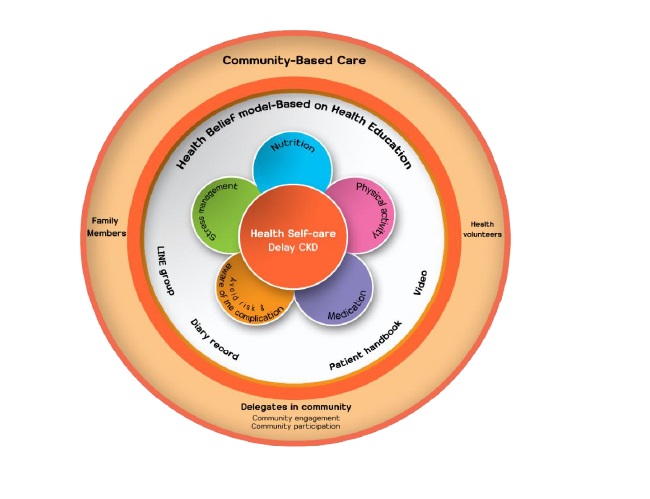การพัฒนารูปแบบการดูแลตนเองที่บ้านและชุมชนเพื่อชะลอไตเสื่อม ของผู้ป่วยโรคเบาหวาน จังหวัดสกลนคร
คำสำคัญ:
รูปแบบการดูแลตนเอง, ชะลอไตเสื่อม, ผู้ป่วยโรคเบาหวาน, การดูแลที่บ้านและชุมชนบทคัดย่อ
การวิจัยเชิงปฏิบัติการนี้มีวัตถุประสงค์ 1) เพื่อศึกษาสถานการณ์และบริบทเกี่ยวกับการดำเนินงานเพื่อชะลอไตเสื่อม 2) เพื่อพัฒนารูปแบบการดูแลตนเองที่บ้านและชุมชนเพื่อชะลอไตเสื่อมของผู้ป่วยโรคเบาหวาน และ 3) ประเมินประสิทธิผลของรูปแบบ เครื่องมือที่ใช้ในการวิจัย ได้แก่ แบบสอบถาม และแนวคำถามในการสนทนากลุ่ม วิเคราะห์ข้อมูลเชิงคุณภาพโดยใช้การวิเคราะห์เนื้อหา จัดหมวดหมู่เนื้อหา ข้อมูลเชิงปริมาณใช้สถิติค่าร้อยละ ค่าเฉลี่ย ค่ามัธยฐาน ค่าส่วนเบี่ยงเบนมาตรฐาน สถิติ Independent t-test และสถิติ Dependent t-test ผลการวิจัยพบว่า
1. สถานการณ์และบริบท พบว่า ผู้ป่วยมีระดับความรู้เกี่ยวกับการดูแลตนเองและพฤติกรรมการดูแลตนเองอยู่ในระดับปานกลาง ความต้องการพัฒนาแนวทางในการจัดการเพื่อชะลอไตเสื่อมในชุมชนควรจัดทำสื่อการให้ความรู้ที่น่าสนใจทำให้ประชาชนได้รับทราบข่าวสารอย่างทั่วถึงและสามารถสื่อสารให้ผู้ป่วยเข้าใจได้ง่าย
2. รูปแบบที่พัฒนา คือ SELF CKD Model ประกอบด้วย พฤติกรรมการดูแลตนเองเพื่อชะลอไตเสื่อม การส่งเสริมสนับสนุนให้ผู้ป่วยดูแลตนเอง การมีสื่อการเรียนรู้ มีบุคคลที่จะมาช่วยเหลือและสนับสนุนให้ผู้ป่วยดูแลตนเอง การใช้ชุมชนเป็นฐานและการมีส่วนร่วมในการสนับสนุนให้ผู้ป่วยพึ่งพาตนเอง ความรู้เกี่ยวกับการชะลอไตเสื่อมของผู้ป่วย ครอบครัว ชุมชน การตั้งเป้าหมายและผลลัพธ์ที่ต้องการให้เกิดขึ้นของผู้ป่วย
3. ผลลัพธ์กับผู้ป่วยหลังการใช้รูปแบบกลุ่มทดลองมีความรู้เกี่ยวกับการดูแลตนเอง (p<0.001) พฤติกรรมการดูแลตนเอง (p<0.001) และการรับรู้ด้านสุขภาพเพื่อป้องกันโรคไตเสื่อม (p<0.001) มากกว่าก่อนการทดลอง อย่างมีนัยสำคัญทางสถิติ
ดังนั้นสามารถนำรูปแบบที่พัฒนาขึ้นไปเป็นแนวปฏิบัติสำหรับเจ้าหน้าที่ผู้ปฏิบัติงานในสถานพยาบาลและชุมชนในการส่งเสริมพฤติกรรมการดูแลตนเองเพื่อป้องกันความเสื่อมของไตในผู้ป่วยเบาหวานโดยประยุกต์ให้สอดคล้องกับบริบทของพื้นที่ต่อไป
เอกสารอ้างอิง
American Diabetes Association. (2017). Standards of Medical Care in Diabetes 2017. Clinical Diabetes, 35(1), 5–26.
Armstrong, N., Herbert, G. & Brewster, L. (2016). Contextual Barriers to Implementation in Primary Care: an Ethnographic Study of a Programme to Improve Chronic Kidney Disease Care. Family Practice, 33(4), 426–431.
Bodenheimer, T., Wagner, E. H. & Grumbach, K. (2002). Improving Primary Care for Patients with Chronic Illness. JAMA, 288(14), 1775–1779.
Bureau of Non-Communicable Disease. (2015). Annual Report 2015, Bureau of Non-Communicable Diseases Department of Disease Control. Bangkok: Bureau of Non-Communicable Diseases Department of Disease Control. (In Thai).
Janyam, P., Thabthong, U., Oncharoen, W., & Sawangsri, W. (2021). Development of a Web Application for Reporting Laboratory Results to Patients with Diabetes in Health Promoting Hospitals of Suphanburi. The Southern College Network Journal of Nursing and Public Health, 8(3), 296–308, (in Thai)
Jiamjariyapon, T., Ingsathit, A., Pongpirul, K., Vipattawat, K., Kanchanakorn, S., Saetie, A. et al. (2017). Effectiveness of Integrated Care on Delaying Progression of Stage 3-4 Chronic Kidney Disease in Rural Communities of Thailand (ESCORT Study): a Cluster Randomized Controlled Trial. BMC Nephrology, 18(1), 83.
Kemmis, S., McTaggart, R. & Nixon, R. (2014). The Action Research Planner Doing Critical Participatory Action Research. Singapore: Springer.
Kidney International Supplement. (2017). KDIGO 2017 Clinical Practice Guideline Update for the Diagnosis, Evaluation, Prevention, and Treatment of Chronic Kidney Disease-Mineral and Bone Disorder (CKD-MBD). Official Journal of The International Society of Nephrology, 7(1), 1–59.
Kurnia, A. D., Amatayakul, A. & Karuncharernpanit, S. (2017). Predictors of Diabetes Self-management among Type 2 Diabetics in Indonesia: Application Theory of the Health Promotion Model. International Journal of Nursing Sciences, 4(3), 260–265.
Lee, M. C., Wu, S. F. V., Hsieh, N. C. & Tsai, J. M. (2016). Self-Management Programs on eGFR, Depression, and Quality of Life among Patients with Chronic Kidney Disease: A Meta-Analysis. Asian Nurses Res (Korean Soc Nurses Sci), 10(4), 255-262.
Munshi, M. N., Segal, A. R., Suhl, E., Ryan, C., Sternthal, A., Giusti, J. et al. (2013). Assessment of Barriers to Improve Diabetes Management in Older Adults: a Randomized Controlled Study. Diabetes Care, 36(3), 543–549.
Nimmanit, S. (2017). Diabetes and Kidney. Retrieved December 6, 2021. From http://www.si.mahidol.ac.th/sidoctor/e-pl/articledetail.asp?id=316. (In Thai).
Orem, D. E. (2001). Nursing: Concepts of Practices. (6th ed). St. Louis: Mosby Year Book.
Permanent Secretary, Ministry of Public Health. (2017). P&P Excellence Forum 2017. Retrieved December 6, 2021. From http://bps.moph.go.th/new_bps/sites/ default/files/PPExcellenceForum2017.pdf. (In Thai).
Rosenstock, I. M., Strecher, V. J. & Becker, M. H. (1988). Social Learning Theory and the Health Belief Model. Health Education Quarterly, 15(2), 175–183.
Sakon Nakhon Provincial Health Office. (2018). Chronic Kidney Disease Screening Information for the Year 2018. Sakon Nakhon Provincial Health Office, Sakon Nakhon. (In Thai).
Sereewiwattana, M., Thongtanunam Y. & Limakkara S. (2018). Improving the Quality of Care for Chronic Patients to Slow Renal Impairment by Using the Concept of Caring for Chronic Patients of Tambon Health Promoting Hospitals. Thai Journal of Nursing and Midwifery Practice, 5(1), 45–56. (In Thai).
Stufflebeam, D. L. (2000). The CIPP Model for Evalutaion. In D. L. Stufflebeam, G. F. Madaus, & T. Kellaghan (Eds.), Evaluation Models: Viewpoints on Educational and Human Services Evaluation. 2nd ed. Boston, MA: Kluwer Academic.
Tuttle, K. R., Bakris, G. L., Bilous, R. W., Chiang, J. L., de Boer, I. H., Goldstein-Fuchs, J. et al. (2014). Diabetic Kidney Diseases: a Report from an ADA Consensus Conference. American Journal of Kidney Diseases: The Official Journal of the National Kidney Foundation, 64(4), 510–533.
Wagner, E. H. (2019). Organizing Care for Patients with Chronic Illness Revisited. Milbank Q. Sep; 97(3), 659-664. Retrieved November 10, 2021. from https://pubmed.ncbi.nlm.nih.gov/31424130.
World Health Organization. (2004). Comprehensive Community and Home-based Health Care Model. India: WHO.
World Health Organization. (2017). Global Report on Diabetes. Retrieved November 10, 2021. From https://apps.who.int/iris/bitstream/handle/10665/204871/9789241565257_eng.pdf.

ดาวน์โหลด
เผยแพร่แล้ว
ฉบับ
ประเภทบทความ
สัญญาอนุญาต
ลิขสิทธิ์ (c) 2023 วารสารเครือข่ายวิทยาลัยพยาบาลและการสาธารณสุขภาคใต้

อนุญาตภายใต้เงื่อนไข Creative Commons Attribution-NonCommercial-NoDerivatives 4.0 International License.
1. บทความหรือข้อคิดเห็นใด ๆ ที่ปรากฏในวารสารเครือข่าย วิทยาลัยพยาบาลและการสาธารณสุขภาคใต้ ที่เป็นวรรณกรรมของผู้เขียน บรรณาธิการหรือเครือข่ายวิทยาลัยพยาบาลและวิทยาลัยการสาธารณสุขภาคใต้ ไม่จำเป็นต้องเห็นด้วย
2. บทความที่ได้รับการตีพิมพ์ถือเป็นลิขสิทธิ์ของ วารสารเครือข่ายวิทยาลัยพยาบาลและการสาธารณสุขภาคใต้







